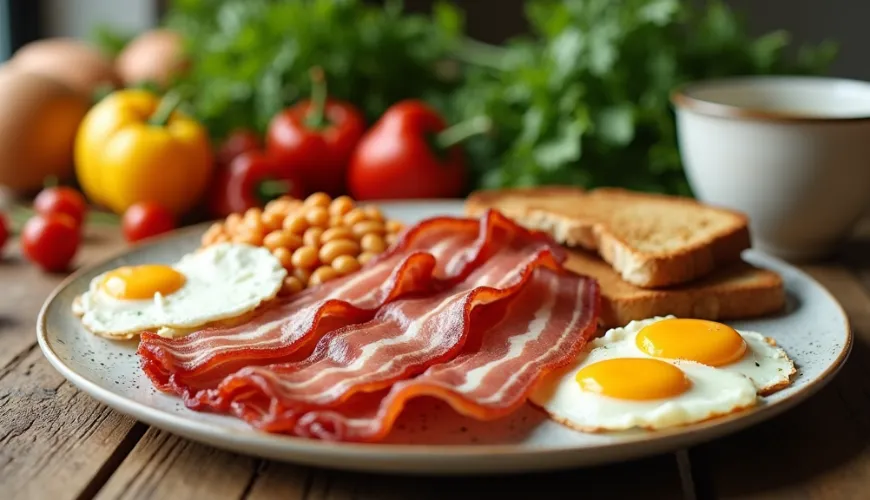
English bacon recipe that will boost your confidence in the kitchen

Real English Bacon - Recipe, Tradition, and Flavor That Never Tires
Few foods can boast such universal use as bacon. And when you mention English bacon, many people envision that iconic combination of meat and fat that adds flavor to an English breakfast, enriches sandwiches, or serves as an excellent base for many other dishes. But what if there was a way to prepare real English bacon at home? Without additives, without artificial flavors – just with quality meat, simple ingredients, and a bit of patience.
Today, we will explore what makes English bacon special, its origins, and most importantly – how to make it at home. If you're looking for a recipe for real English bacon, you're in the right place.
What does "English bacon" actually mean?
Unlike traditional Czech bacon, which is often made from pork belly and has a high fat content, English bacon comes from pork loin or shoulder. The result is meat with less fat and a firmer structure, making it ideal for frying and cold dishes. In Britain, it is known as "back bacon" and is an integral part of the traditional English breakfast along with eggs, beans, sausages, and toast.
It is a product that combines the taste of cured meat with a subtle smoky note. In industrial production, nitrites or phosphates are often added to enhance color and shelf life, but at home, you can manage with ordinary salt, sugar, and spices.
Homemade English Bacon
Preparing homemade English bacon is not complicated, but it requires time and care. The result, however, is a quality product that not only tastes great but also lets you know exactly what it contains.
What you will need:
- 1.5 kg of pork loin or shoulder without bone (preferably from a farmer or organic source)
- 70 g of sea salt or curing salt
- 30 g of brown sugar (you can also use maple syrup for a milder flavor)
- 1 teaspoon of freshly crushed black pepper
- a few bay leaves
- 1 teaspoon of ground paprika
- optionally: crushed garlic, thyme, rosemary, or juniper
- smoking option: wood chips (e.g., beech, cherry, or apple)
Procedure:
-
Prepare the meat: Clean the meat, dry it, and remove any large membranes or excess fat. If the meat is too thick, you can cut it lengthwise to better absorb the cure.
-
Curing: In a bowl, mix salt, sugar, and spices. Thoroughly rub the mixture on all sides of the meat. Place it in a container or zip-lock bag, seal well, and refrigerate for 5–7 days. Turn the meat daily and gently massage it to distribute the brine evenly.
-
Rinsing and drying: After curing, remove the meat, rinse under cold water, and dry it. Then leave it uncovered in the fridge for several hours (ideally overnight) to dry the surface – this is important if you plan to smoke it.
-
Smoking (optional): If you have a home smoker, you can smoke the meat with cold smoke at a temperature of 20–30°C for 6–8 hours. The wood should be hard and resin-free. Smoking adds the classic English flavor and extends the meat's shelf life.
-
Aging: After smoking (or even without it), let the meat rest in the fridge for another 2–3 days. Then it's ready to slice.
The result? A fragrant, mildly salty bacon with a rich flavor that tastes great both cold and quickly fried in a pan. It's perfect for breakfast sandwiches, omelets, or as a base for pasta dishes.
Why make English bacon at home?
You might be wondering – why bother when I can buy bacon at the store? The answer is simple: quality. Most commercially produced bacon contains nitrites, stabilizers, flavor enhancers, and often added water. The result is usually a product that releases liquid when fried rather than crisping up.
Additionally, with the homemade version, you can choose the intensity of salt, the type of spices, and the level of smoking. And most importantly – you know exactly what you're eating.
An example is the experience of Mrs. Jana from Tábor, who decided to make her own bacon after reading the ingredients on a regular product label. "The meat made up barely 70 percent, the rest were various additives, water, and starch. At that moment, I knew I wanted something better for myself and my children," she says. Her homemade bacon quickly became a hit in the family and among friends.
Real English Bacon - A Tradition That Endures
In Britain, bacon truly holds a special place. According to surveys, it remains one of the most popular breakfast foods, despite healthy lifestyle trends. Real English bacon is not just about the meat – it's a part of culture, tradition, and daily life.
If you're enticed by authenticity and the taste of home, there's nothing more satisfying than preparing real English bacon according to a traditional recipe. In combination with homemade bread, an egg, and tomato, you'll create a meal that delights both the taste buds and the heart.
And furthermore – even though it may sound surprising – homemade bacon can also be part of a healthy diet if consumed in moderation and prepared from quality ingredients without unnecessary chemicals. In combination with fresh vegetables, whole-grain bread, or eggs, it forms a complete meal full of proteins.
How to Use English Bacon
English bacon is a great helper in the kitchen – you can fully use it from breakfast to dinner. Just slice it thinly and fry it for the classic morning combination, or chop it into cubes and add it to creamy pasta. It's also great between slices of homemade bread with a poached egg, perfect for a quick brunch. It works wonderfully baked in quiche or savory pies, and if you're in the mood for a salad, feel free to add it – it will satisfy and add a kick.
Unlike common industrial bacon, homemade bacon smells wonderful, doesn't release water, and retains its texture even after cooking. And the best part – once you make it yourself, you're unlikely to go back to store-bought.
As culinary classic Anthony Bourdain says: "When in doubt, fry bacon. It will make you happy." And if that bacon is homemade and carefully prepared – the joy is doubled.

